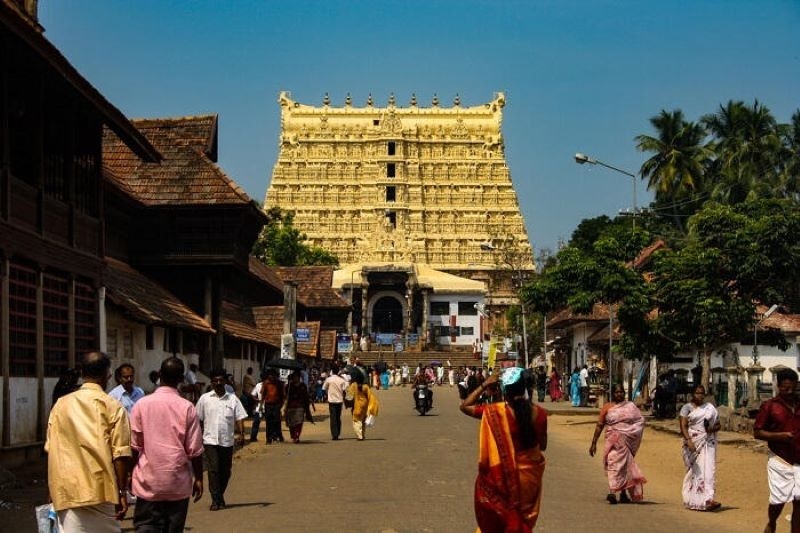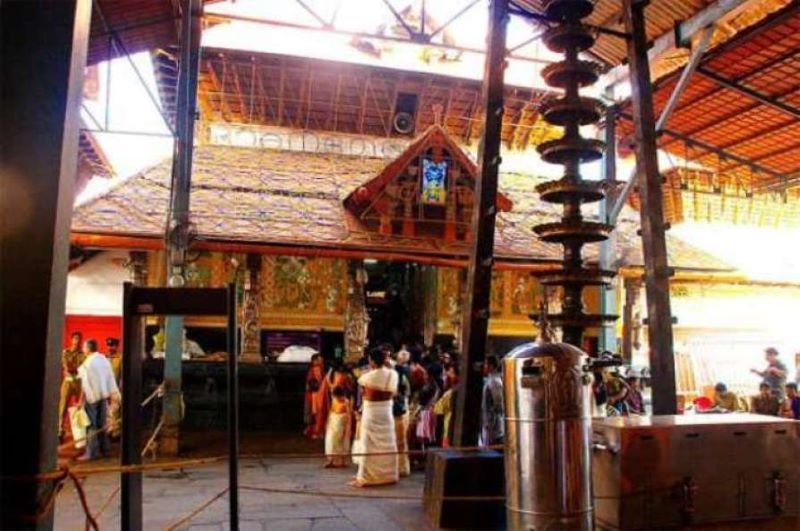Urge to Loot Hindu Temples Shows Medieval Mindset

By Ratan Sharda
The mindset and the politics at work behind this sinister cabal comes straight from the horse’s mouth, from a gentleman named Jamal Mecklai, an advisor to the RBI. Sandeep Balakrishnan tells us that he proposed about 6-7 years back through the Congress party (who else?) a move to take over the gold held by major temples in India—from Tirupati to Shirdi to Siddhivinayak to Padmanabhaswamy.
Loot of Hindu temples never stopped since the first hordes of invaders came 1000 years back; nor did stop the breaking of temples and usurping their properties. Even after 1947, the war against Hindus continued. A law made by the British in 1925 for taking over Hindu temples in Tamil Nadu with an excuse that they were being mismanaged, has been made into a canon by all successive governments. This law was weaponized by various state governments, especially in the South to take over all the temples that reasonably wealthy and divert their funds to feather their nests and use the funds to overcome their own inefficiency.
Temples once used to be the center of a town that would nurture the industry, education, culture, farming, irrigation, village upkeep, etc. Kings too would contribute to the temples for this purpose. The late king of Thiruvananthapuram, who built grand Padmanabhaswamy temple, in fact, handed over the kingdom to Bhagwan Padmanabha and served as his servant. His offerings kept enriching the temple coffers.
Against this background, what did our secular rulers, brought up with colonial mindset do? They expanded the scope of this law to control temples in almost all the states of India. The feeble democratic protests of the devotees fell on deaf years.
Below is the saga of the loot of Hindu temples under independent India, totally in violation of the spirit of secularism that gave equal rights to all citizens to practice and propagate their religions, managed their places of worship and institutions for nurturing their religion. Somehow the articles of Constitution which were made to protect minority practices became a tool of majority oppression.
I had compiled the data below from various sources about two years back for TV debates when an earlier campaign to take over Hindu temples was launched and then some Hindu bodies came out to demand handing over of temples back to Hindus. Some of the sources I have made note of are Stephen Knapp, Dr. Subramanian Swamy who is fighting the case for removing government control from temples, Sandeep Balakrishnan, Amit Malaviya, Rakesh Krishnan Simha and Forum for Religious Freedom. There is more is available with organizations like the Hindu Charter of Demands and those fighting the cases in the courts. But it gives you a fair idea about how the medieval mindset of looting Hindu temples is still alive.
· Tirumala Tirupati temple collects over Rs 3,100 crore every year and 85 percent of this is transferred to the State Exchequer, much of which goes to causes that are not connected with the Hindu community. Imagine, the same temple retrenched 1300 employees this month during Corona crises as it had no money!
· While owing the TTD Rs.1,500 crore already from various earlier proceeds, the government tried hard to take away another Rs 500 crore from TTD for state irrigation projects!
· JRG Wealth Management Limited, a Christian owned organization, was given a lucrative contract to procure materials for the prasadam that is given to temple devotees. Some years back, on January 21, the Chief Minister announced the sponsorship, using TTD money, of a hockey tournament in his parents’ name.
· Under a Temple Empowerment Act, about 43,000 temples in Andhra Pradesh had come under Government control and only 18 percent of the revenue of these temples has been returned for temple purposes, the remaining 82 percent being used for purposes unstated.
· Andhra Pradesh, out of 420,028 acres owned by temples in Vishakhapatnam, Kakinada, Guntur, Kurnool, Warangal, and Hyderabad, 60,843 acres were allowed to be occupied illegally by professional land grabbers. The state government, responsible under the HRCE Act, did nothing to prevent these incursions, even though it has a staff of over 77,000 people (paid from a 15% charge on temple revenues) to look after temple interests.
· In August 2005, the state decided to sell 100,000 acres of the Sri Narasimha Swamy Temple in Simhachalam and other nearby temples. On March 14, 2006, the government auctioned 3,000 acres of temple lands in East Godavari district. Proceeds from these sales rarely reach the temples, which have to depend on the same government for doles to light their lamps and pay their priests.
· In Simhachalam, 300 acres belonging to the temple have been allocated for churches and convent schools, who even exercise an illegal authority to stop devotees from visiting the temple atop the hill!
· There is also an attempt afoot to take over the 500-year-old Chilkur Balaji temple.
· 884 acres of endowment lands of the famous Sri Rama temple at Bhadrachalam have been allocated to Christian institutions by the state government.

· In Karnataka, Rs. 79 crores were collected from about 200,000 temples and from that, temples received Rs 7 crores for their maintenance, Muslim madrassahs and Haj subsidy were given Rs 59 crore and churches about Rs 13 crore. An estimated 50,000 temples have shut down during the last few years in Karnataka due to lack of resources, despite a surplus Rs. 66 crores of Hindu temple money in the hands of the government.
· In the 1980s, the then chief minister K. Karunakaran issued an order that the Guruvayur Sri Krishna Temple Board withdraw Rs 10 crore and deposit in State treasury to help the government out of its financial crisis.
· In Sabarimala, the forested hill with the famous temple of Lord Ayyappa in Kerala, 2,500 acres of temple property have been sold by the Communist government-controlled Travancore Devasvom Board to a non-Hindu group.
· Even though this Board gets about Rs. 250 crores every year in income, it is almost bankrupt today, after years of government diversion of funds. Rs 24 crores from the Guruvayoor Devasvom have been spent on a drinking water project in ten nearby panchayats, which include 40 churches and mosques.
· 47000 acres of temple lands have been usurped by the government in Tamilnadu from 1986.
· Hindu Religious & Charitable Endowments Department has control over more than 4.7 lakh acres of agricultural land, 2.6 crore square feet of buildings, and 29 crore square feet of urban sites of temples.
· By any reasonable measure, the income from these properties should be in thousands of crores of rupees. The government, however, collects a mere Rs.36 crore in rent against a ‘demand’ of mere Rs.304 crore — around 12 percent realization. How much is under the table only a court-monitored inquiry can reveal.

· The Srirangam Ranganathar Temple paid the government a (yearly) fee of Rs. 18.56 crore (2010-11) for ‘administering the temple’; for employees rendering religious services, like reciting Vedas, Pasurams during the deity procession, no salary is paid’.
· There are 36 priests in Srirangam who perform the daily poojas — they are not paid a monthly fixed salary. They are entitled to offerings made by devotees and a share in the sale of Archana tickets. But the temple pays a monthly salary ranging from Rs.8,000 to Rs.20,000 for the temple’s government-appointed employees, like watchman, car drivers etc.
· Lord, thy grace! Priests in Nelliappar Temple in Tirunelveli are better off, getting paid monthly salaries, ranging from Rs. 55-Rs. 72 (and this is during 2010-11).
· In Bihar, government control over the temples through its Hindu Endowments department has resulted, according to the Religious Trust Administrator, in the loss of temple properties worth Rs. 2000 crore.
In a case fought by Dr. Swamy, in their lengthy judgment, the Bench has clearly set the constitutional parameters on the scope of governmental intervention in the management of religious institutions. In particular, the Court has opined that any G.O. that legally mandates a takeover of a temple must be for a fixed limited period, which he had suggested as three years. Recently, Supreme Court too has said that temples must be managed by the devotees. Nothing much has changed.
Now, the Secular test.
Lease deed given to various Church institutions for 99 years by the grace of their British benefactors got over in 1993. Should not the government take back its land to use it for setting up housing for poor or manufacturing of SSI or build health facilities for Corona victims? As it is land acquisition is becoming more and more difficult due to foreign-funded and Church backed NGOs and the Church is the owner of the largest land parcels prime areas.
There are large number of cases of misappropriation of Waqf land by their trustees. Shouldn’t they be taken over and used for better public utilization like setting up of hospitals and technical institutions?
People contribute to the temples for nurturing dharma, not for political purposes. We must also remember that only Hindu temples pay income tax, none of the minority institutions do. The political class has failed to deliver economic justice to the vast multitudes of Indian citizens over 70 years of fake socialism. They wish to hide their failure by looting the temples who are always contributing the national cause. If you think, only temples can save India and they have the resources, then declare India a Hindu Rashtra, hand over temples to their devotees, and see how they nurture Bharat back to health as they had done in earlier times.
